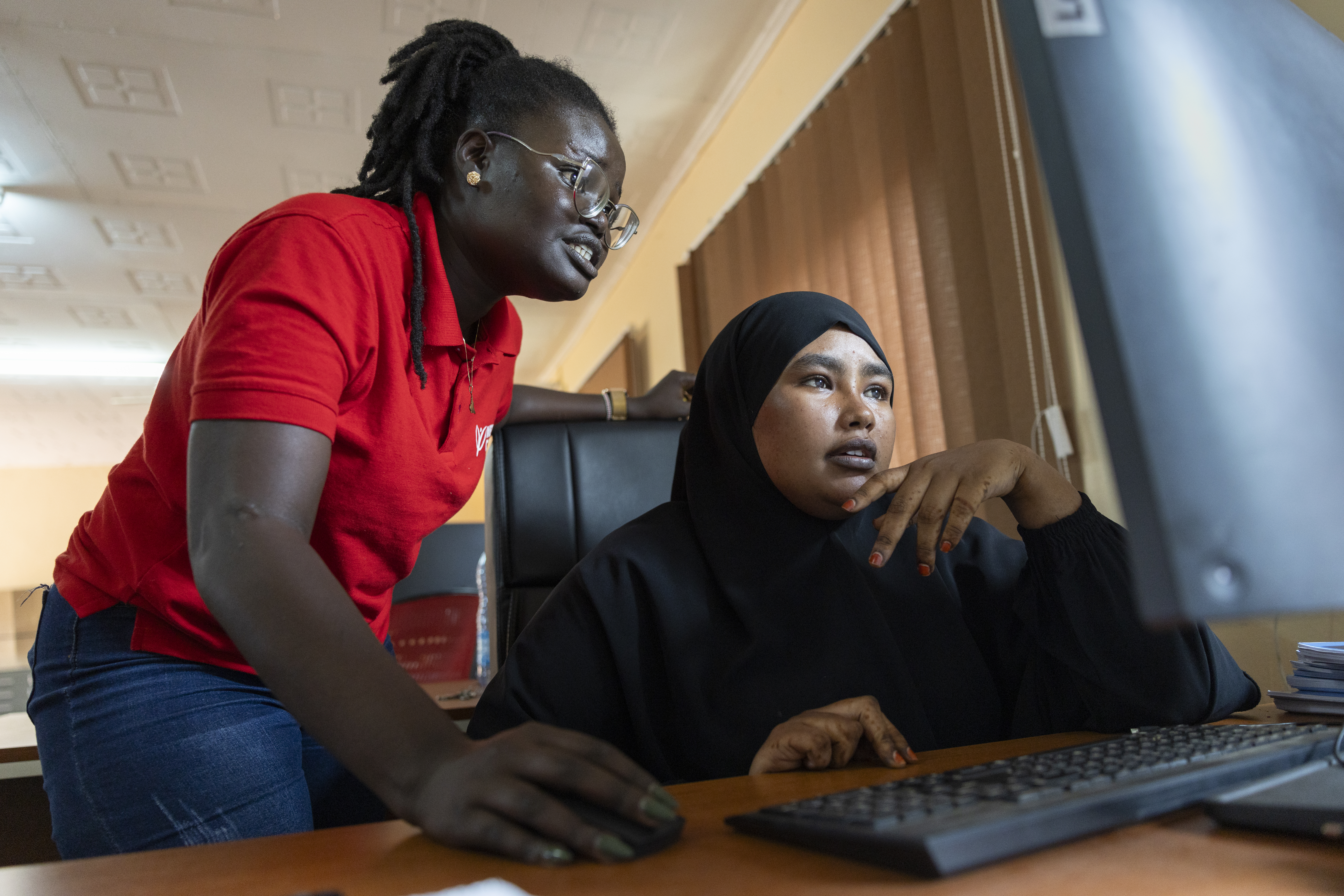Lifting weights and spirits: How a women’s gym forged a friendship

As we drive into the Jordanian town of Kharja, not far from the Syrian border, we see a small building with a beautiful mural painted onto the side — it’s a young woman in a hijab, eyes closed and face tilted toward the hot sun. Words in Arabic script run along one side of the wall. Later, we learn that these are words of encouragement and empowerment.
The mural is a fitting background for a story of everything that can be accomplished when neighbors work together.
Inside the building we meet a bubbly Jordanian woman, Leila, and her quieter friend — a Syrian refugee named Lena. It’s then that we learn that together with Mercy Corps and their local conflict resolution group, Leila and Lena have built Kharja’s first women’s gym.
Lena fled the war in Syria three years ago and found safety in Jordan. But like so many other refugees, the transition to her new life was fraught with hardship. “It was like tragedy for me,” she says. “God knows how long I cried when I got to Jordan.” Her somber tone lightens as she tells us how much she loves the community here now and that she wouldn’t dream of moving, even to live in a better house.

Building relationships between refugees and host communities
In Kharja, a town of 12,000, Lena is one of some 2,000 Syrians who’ve sought refuge here. All over Jordan and Lebanon, towns like this one are now home to significant populations of refugee families. In the beginning, the refugees often feel alone and isolated. Members of the host community bristle at the newcomers. Tensions rise, and clashes aren’t uncommon.
To help refugees and their local neighbors come together, Mercy Corps developed a conflict resolution program that breaks the ice, teaches mediation and negotiation skills, and ends with the completion of a community project.
The groups are made up of both refugees and host community members. Week after week, the groups meet to get to know each other, build their skills and work together on their project. Each project is different, and deciding what each community needs is part of the learning process. Together, each group must brainstorm their ideas, come to a consensus, get the wider community to back their project, and follow it through to completion.
Around the region, we’ve seen the incredible impact of this work. In small cities and towns just like this one, playgrounds, libraries, community centers, soccer fields and medical facilities are popping up. With both refugees and their neighbors invested in these projects, the natural result is spaces where people can gather and begin to dismantle tensions and build connections.
The Syrian refugee crisis is complex and full of challenges. But we know this for certain: bringing refugees and their neighbors together can transform entire communities for good. Friendships are formed, children can play together, men and women of both backgrounds work alongside each other. People learn that they are more alike than they are different — and the fabric of that community changes for the better.
Empowering women through exercise

When we visited Leila and Lena in Kharja, we wanted to know — how did they decide to create a women’s gym? And what was that process like?
They explained that the nearest gym took two hours round trip to get to, not including the time that someone would actually spend exercising. In their brainstorming sessions, a men’s gym and a women’s gym were both proposed. After listening and discussing together, the group decided as a whole that a gym for local women is what the community needed most of all.
The gym didn’t come without its challenges. “Every project has people who go against it, but we rallied them to our side,” Leila says with a charming smile. They explained that the negotiation skills they learned during the training helped them persuade anyone in the community who was unsure of their idea.
Lena’s experience of her community as a refugee changed just as the project evolved. “Once I signed up for the training, it was transformational,” she says. “When I worked side by side with them I only felt respect.”
Now, the gym is up and running and open to all women in the community. The friends describe how, like anywhere in the world, women in Kharja lead busy lives and don’t often take time for themselves.
“Women should dedicate time to themselves,” Lena says as Leila jumps in to echo her sentiments: “As community leaders we are trying to empower women. We are brainstorming with both women and men together.” As they talk proudly of their accomplishments, Leila gives her friend Lena a sweet kiss on the cheek.

The two women show us the equipment area and the brightly lit room for exercise classes. Kharja’s new gym is well-appointed with cardio machines, weights, exercise balls and other aerobic supplies. In the summer months, the women who use the gym get together every month to go on excursions to some of Jordan’s historic places. In the winter, they use the gym as a gathering place to chat and relax.
As we walk outside to admire the mural, the two women gather herbs from the building’s garden and press them kindly into our hands. It’s clear that Leila and Lena are proud of what they’ve built together. They know the impact this place will have — for local women, for the small community they both call home and for any new refugees who arrive here.
The seeds of change start small. And right here, in a town near the Syrian border, Leila and Lena’s project is in full bloom.


